Affiliate Programs vs. Ambassador Programs Explained
Trying to understand the difference between affiliate and ambassador programs? This guide breaks down everything brands should know about how both...
Thinking about building a team of brand ambassadors? In this post, we break down the most common types of brand ambassador programs and how they work.


Brand ambassador programs are booming right now.
That’s because modern consumers overwhelmingly trust everyday buyers over brands. We think social media strategist Jenni Li Fowler says it best:
“Today’s consumers seek authenticity . . . Who better to serve as brand ambassadors than people who love your brand so much that they create content for their personal channels bragging about you?”
Want to promote your products with a personal touch? Partnering with ambassadors can make it happen. Thing is, there is no one-size-fits-all approach to recruiting people to promote you.
That's why we put together this post where you'll learn:
Skip to Section 👇What is a Brand Ambassador Program?What Are the Four Types of Brand Ambassador Programs? |
A brand ambassador program is a company initiative where brands partner with social media creators (and customers) for promotions. These ambassadors will then post about brands in exchange for compensation, commission or gifted products.
A brand ambassador is simply a person approved by a company to raise awareness for the company.
Ambassadors can be any combination of the following:
What an “ambassador” looks like varies wildly from brand to brand. Massive brands might exclusively promote celebrity ambassadors. For example, Zendaya is a brand ambassador for companies like Smartwater and Valentino.
But many modern brand ambassador programs are based around smaller, everyday creators.
This strategy has proven effective for up-and-coming brands that want to raise awareness without resorting to celebrity endorsements. Given the popularity of ambassador programs at large, it’s working!
Good question! There’s a lot to unpack but here’s a quick, step-by-step summary:
There is no “right” approach to take when it comes to building your team of ambassadors.
Factors such as your goals, business size and industry all impact which type of brand ambassador program makes the most sense for you.
That’s what we break down below! We’ll also highlight examples of companies with brand ambassador programs to illustrate what each one actually looks like in practice.
For requirement-driven ambassador programs, brands set specific guidelines (think: requirements) for members and their content.
In short, participants are required to complete activities within specific timeframes to fulfill their duties as ambassadors. This includes:
These are among the most popular types of brand ambassador programs for a few reasons.
For starters, companies can directly control their budgets when they set their own ambassadorship requirements. Many brands only send gifted products to their select roster of ambassadors. This keeps your program smaller in scope but also keeps your budget in check.
Requirement-driven programs tend to attract influencers and creators who’ve already worked with brands. You can set the bar as high as you want to reach your “inner circle.”
For example, you might limit your program to a specific engagement rate or audience reach. Brands like Dia & Co actually have a 5,000-follower requirement for ambassadors on TikTok, Instagram and YouTube.
Another benefit of having a requirement-driven program is targeting certain consumers. Choosing influencers based on their audiences means marketing to more specific demographics. In turn, this increases the quality of content and your campaign results.
Requirement-driven brand ambassador programs are versatile, too. They’re effective for just about any industry. This includes CPG, beauty, fashion, tech, food and lifestyle.
|
Pros |
Cons |
|
|
The Sarah Flint ambassador program is a great example of a selective and exclusive program with big perks.
For example, the company states that they go out of their way to help their ambassadors promote their personal brand. The company also mentions upfront how they promote ambassadors throughout their marketing campaigns and social channels. Testimonials from the program’s participants speak for themselves.
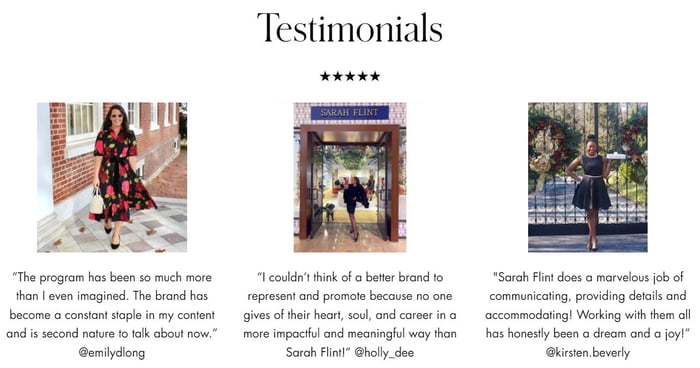
Oh, and accepted ambassadors also get a free pair of shoes. Like many other types of ambassador programs, Sarah Flint promotes a tiered reward system for ambassadors that score high sales numbers.
Another example of this type of ambassador program is from Klairs. Note that the company narrowed its latest ambassador hiring round to only 100 people. The brand also emphasizes how they want to attract ambassadors that really understand the company and its values. This highlights how setting requirements can improve the quality of your ambassadors.
This type of brand ambassador program is based around an affiliate marketing structure.
In short, ambassadors promote a company’s products in exchange for a small commission. Purchases are tracked when someone uses the ambassador’s promotional code or link. These custom, trackable codes are provided to accepted ambassadors by the brand.
With affiliate marketing programs, both the brand ambassador and the company stand to benefit. Brand ambassadors that drive more sales earn higher commissions. When streamlined, affiliate marketing represents a low-risk way to promote your company’s products.
That said, it's not always easy to track link attribution on social media. For example, jumping through hoops to get to someone's bio link is obviously annoying. Because of this, some influencers aren’t big fans of promoting via promo codes and links. You can also run into instances where people buy from an influencer but never actually redeem their code.
While affiliate marketing can be effective, it does carry a certain reputation. According to data from Sprout Social, the biggest reason people unfollow influencers is because they post too much promotional content. When an ambassador’s account is only affiliate links, followers get fatigued.
However, there’s no denying the popularity of this type of ambassador program. This speaks to the importance of both vetting affiliates and providing meaningful perks to drive people to want to promote your brand. Affiliate programs are a low-effort way to drive sales through people that already know and love your products.
For more about the distinction between affiliates and ambassadors, check out this post.
|
Pros |
Cons |
|
|
Medicube’s affiliate program offers 10% commission and 10% off on future products for accepted members. Below is a quick breakdown of their affiliate perks and process from their Instagram Stories.
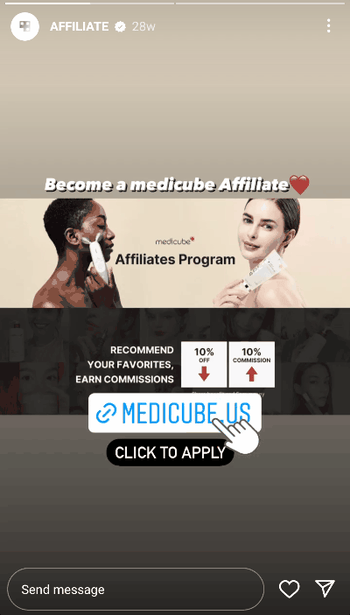
Source: @medicube_global_official
The HydroJug ambassador program follows the affiliate structure as well. This program is front-and-center with a ton of perks. This includes exclusive products, discounts, monthly giveaways and shout-outs via social media.
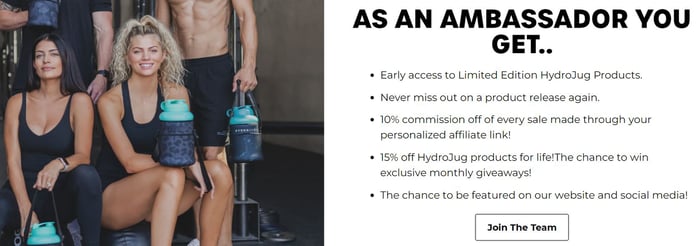
Again, an added bonus of joining an ambassador program for creators is promotion and exposure. If you have a following as a brand, you can offer that perk upfront.
College ambassador programs are affiliate programs centered around college students.
In short, brands partner with students to raise awareness and boost sales. Consider that colleges and universities are host to massively targeted groups of consumers. They're the ones most in tune with social marketing, too. These types of brand ambassadors can be extremely valuable for relevant brands.
Consider that influencer marketing is most effective among younger consumers. College-aged consumers are the perfect candidates for both being ambassadors and buying from them.
As a result, this type of program is perfect for companies that want to reach the college crowd. College brand ambassadors use word-of-mouth through social media to drive sales. They might also use affiliate links as well.
Creative ambassadors often use guerrilla marketing tactics to promote brands on campus. For example, an ambassador might hand out product samples to students or host branded events. The best college brand ambassadors are outgoing and authentically excited about your products.
The caveat here? This type of ambassador program only really works for brands targeting specific demographics. Also note that some colleges and universities have strict on-campus promotional policies. Make sure you review those before getting started.
|
Pros |
Cons |
|
|
Perhaps the best example of a college ambassador program comes from Dormify. Not only do they sell products for college students but their ambassadors are active on campuses across the country. The program even promotes itself as a way for budding content creators to build their portfolios and get experience working with brands.
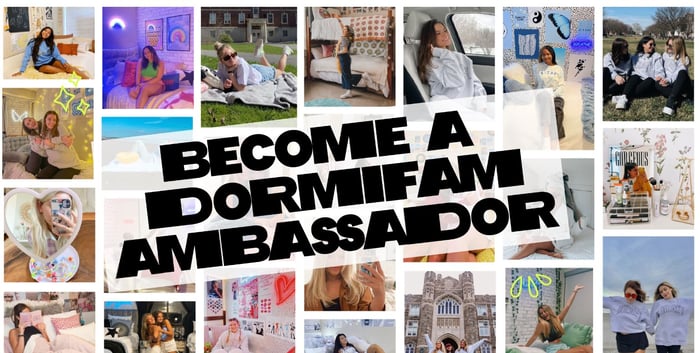
Both on Instagram and TikTok, you don’t have to look hard to find a member of the #dormifam promoting their dorm room inspo.
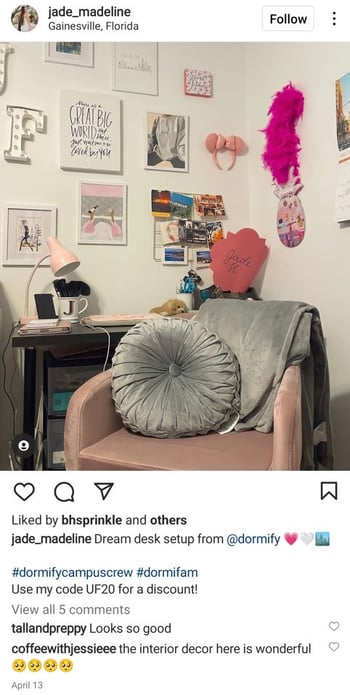
Source: @jade_madeleine
The massively popular SHEIN Campus Ambassador Program is another great example. The application and acceptance process is similar to that of any other affiliate program at a glance. That said, SHEIN is big on community and likewise their ambassador perks which include custom care packages.
Some companies promote “unofficial” brand ambassador programs that anyone can join.
An informal program is basically an independent customer community that promotes your brand and its products organically.
For example, you might have a branded community hashtag on Instagram or TikTok to encourage people to share their latest purchases. You can then reward the best customer ambassadors you see with gifted products. Alternatively, you could hold a monthly giveaway or contest for people that tag your brand.
These programs don’t require vetting people or managing relationships. Likewise, you can attract “ambassadors” of all shapes and sizes. The obvious downside to this type of “program” is that you don’t really have much control over what people say.
That said, if you have a good rapport with your community you might not have to. Informal programs can be incredibly powerful when you have customers constantly shouting you out.
|
Pros |
Cons |
|
|

The Nest brand ambassador program page simply invites customers to tag their products on Instagram.

Black Milk Clothing is a shining example of a brand that earns constant ambassador-style content just from hashtag mentions. The brand likewise reposts their customer content all the time. In short, everyday customers serve as their best ambassadors.
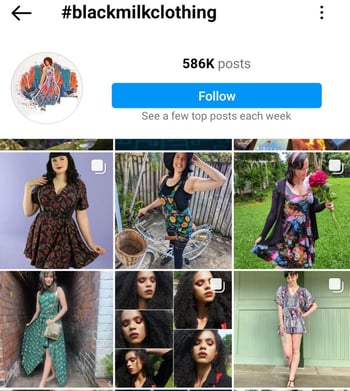
Source: @blackmilkclothing
Meanwhile, Shapermint has both a formal and informal ambassador program. In addition to their apply-only program, they also invite customers to “join their community” of 5+ million plus people. This again highlights how everyday customer ambassadors can spread the word.

Creating a brand ambassador program is totally worth it for businesses today.
That’s because there are so many eager and talented ambassadors out there that want to shout out the brands they support.
Once you’ve figured out which type of ambassador program you want to build, you need to attract and vet the creative talent to boost your program long-term. You can kickstart your efforts with a high volume of creators posting about your brand.
And if you need a scalable way to get more influencer content faster, Statusphere can help.
Our micro-influencer software matches brands with vetted influencers from our creator community. Unlike other platforms, we guarantee a specific volume of content for our brands long-term.
Statusphere eliminates the most time-consuming pieces of working with creators in-house thanks to our advanced matchmaking and fulfillment technology. We’ve already generated 75,000+ pieces of content for 400+ consumer brands.
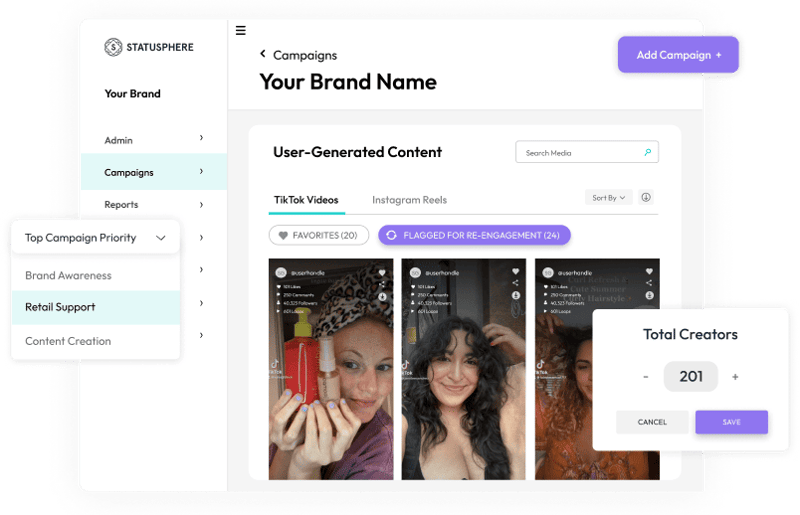
Want to see how our platform works? Get in touch with one of our experts to learn how we can optimize your brand’s creator marketing efforts with guaranteed content at scale
This article was first published in July 2017. It was last updated May 19, 2022.
Trying to understand the difference between affiliate and ambassador programs? This guide breaks down everything brands should know about how both...
Building a brand ambassador program requires plenty of planning. These ambassador program templates and outlines so you can start growing yours...
Ready to recruit brand ambassadors on Instagram? Here's what your pitches should say and how to get the right ambassadors for your brand.
Be the first to know about the latest tools, trends and strategies in influencer marketing for brands.